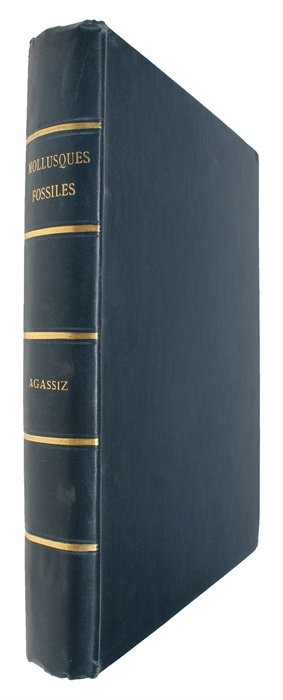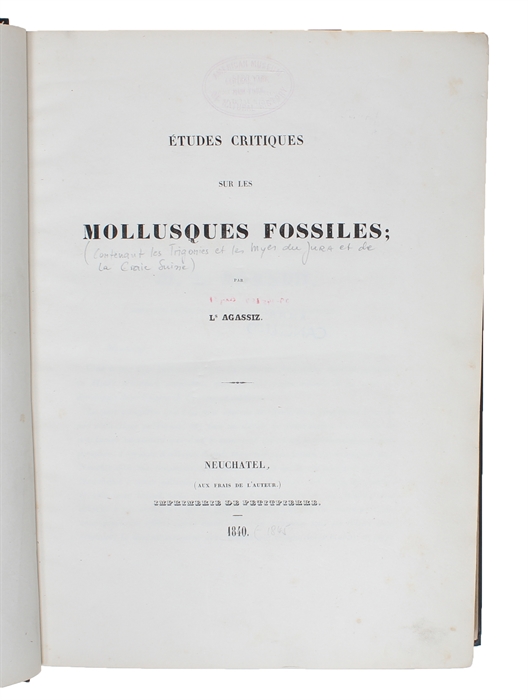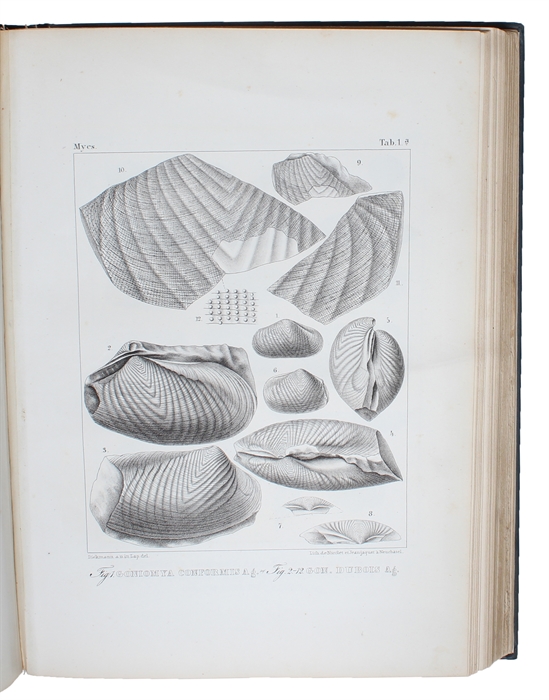AGASSIZ, (JEAN LOUIS RODOLPHE).
Études critiques sur les Mollusques fossiles; (contenant les Trigonies et les Myes du Jura et de la Craie Suisses). (4 Parts).
Neuchatel, (Aux frais de L'Auteur Imprimerie de Petitpierre, 1840 - (1845).
Folio. Bound uncut in one later full blue cloth w. gilt back. A faint stamp to title-page. (6), II, 58 pp.; XXII, 141, (3) pp.; 143-230, (1) pp.; 231-287 pp., 105 lithographed plates with numerous figures. Internally fine, with only a few scattered brownspots and a bit of foxing to a few quires.
The scarce first edition of Agassiz' important work on the fossil mollusks, which helped change the study of fossils and the understanding of natural history.
The famous Swiss-American paleontologist and geologist, Jean Louis Rodolphe Agassiz (1807-1873), counts as one of the most important contributors to the understanding of the natural history of the earth and the creatures on it. "By 1873, despite Darwin, Agassiz' name was synonymous with the study of natural history." (D.S.B. I:74).
Agassiz was born in Fribourg in Switzerland in 1807. He originally studied medicine but went on to also study philosophy and biology at the universities of Zürich, Heidelberg and Munich. In Erlangen he received the doctorate of both philosophy (1829) and medicine (1830). After that, he moved to Paris, where he got personally acquainted with Humboldt and Cuvier, who put him on the track of geology and zoology, the two disciplines that later came to be so closely connected to his name. Initially, the study of ichthyology was that brought him worldwide fame. In 1846 Agassiz travelled to America in order to give a lecture at the Lowell Institute in Boston and in order to study the natural history and geology of North America. Agassiz ended up staying in America, where he was became professor at the University of Harvard. "Jean Louis Rodolphe Agassiz, a Swiss naturalist, was appointed in 1848 professor of zoology at Harvard University where he founded the museum of comparative Zoology and became one of the greatest teachers of biology and natural sciences of the nineteenth century." (Printing and the Mind of Man 309 (main reference: Agassiz' "Études sur les Glaciers, 1840).
Agassiz was a hugely influential but later also controversial scientist. His discoveries in many branches of natural history, from that of mollusks and fish to that of glaciers were of groundbreaking character and they greatly influenced the biologists, zoologists and geologists of his time; however, he did not himself subscribe to the ideas that his discoveries prompted and he was later viewed quite critically as a supporter of radical racial theories, causing his work to be termed "scientific racism".
"Ironically his many important discoveries provided much material for men such as Darwin and Lyell, while his conservative philosophical assumptions led him to resist dogmatically the great changes in the interpretation of nature that they were bringing about." (PMM 309).
The present work constitutes an excellent example of Agassiz' amazing desire to record data and present it accurately and precisely described, which led him to become one of the most important naturalists of classical biology at a time when it faced the transition to evolutionary biology.
"Agassiz (1807-1873) was born in Switzerland, and rose to distinction by his scientific work in Europe, but he went to the United States when he was still only forty-two years of age, and spent the last twenty-seven years of his life as an energetic and successful leader of science in his adopted home. His fame is thus both European and American, and the geologists of New England, not less than those of Switzerland, may claim him as one of their most distinguished worthies." (Archibald Geike in The Founders of Geology).
Nissen ZBI:39 - BMC (NH) I:p.17.
Order-nr.: 38387



